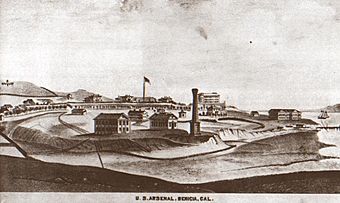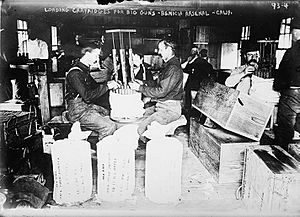Benicia Arsenal facts for kids
Quick facts for kids |
|
|
Benicia Arsenal
|
|

The arsenal in 1878
|
|
| Location | Benicia, California |
|---|---|
| Built | 1849 |
| NRHP reference No. | 76000534 |
| Added to NRHP | November 7, 1976 |
The Benicia Arsenal was a very important military base in Benicia, California. It was located right next to Suisun Bay. For over 100 years, from 1851 to 1964, it was the main place for the U.S. Army to store and manage weapons and supplies on the West Coast. It also included the Benicia Barracks, which operated from 1852 to 1866.
Contents
How the Benicia Arsenal Started
The land for the arsenal was bought in 1847. It was about 252 acres. The first soldiers arrived on April 9, 1849. They set up camp to create the Benicia Barracks. In 1851, a general named Persifor F. Smith suggested that a supply depot for military weapons be built there. This became the first such depot in the West. In 1852, it was officially named the Benicia Arsenal. Famous military leaders like Ulysses S. Grant were stationed there early on.
The Unique Camel Corps
The Benicia Arsenal is also known for housing part of the Army's Camel Corps. This was a short-lived experiment where the Army tried using camels for transportation. The Camel Corps ended in 1863. However, the special barns built for the camels in 1855 are still there today. They are now part of the Benicia Historical Museum.
Benicia Arsenal During Major Wars
The arsenal played a big role in several major wars.
Civil War and Spanish-American War
During the American Civil War, the Benicia Arsenal was a key gathering point. Union troops from the West prepared for duty there. The base remained active until 1898. At that time, soldiers were sent to the Philippines during the Spanish–American War. From 1911 to 1913, Colden Ruggles commanded the arsenal. He later became the Army's Chief of Ordnance.
World War I and World War II
During World War I, the Benicia Arsenal provided weapons and supplies. It supported all large Army bases in the Western States. It also sent materials to American forces fighting in Siberia.
After the attack on Pearl Harbor in 1941, the arsenal quickly sent out supplies. In just 24 hours, 125 truck convoys left the base. They carried ammunition, small weapons, and explosives. This left the arsenal's own stock completely empty. Throughout World War II, the arsenal supplied ports with weapons, artillery, parts, and tools. Workers also repaired thousands of binoculars and watches. They even made 180,000 small items for tanks.
The arsenal is most famous for helping Jimmy Doolittle's raid on Tokyo. On April 18, 1942, the arsenal supplied the bombs for the first bombing raid on Tokyo. These bombs were launched from the USS Hornet.
Workers at the Arsenal
Before 1940, the arsenal had about 85 civilian employees. By October 1942, this number had grown to 4,545. During World War II, there was a shortage of workers. The commander had to use 250 Italian and 400 German prisoners of war. Also, 150 young people from the California Youth Authority worked there. Nearly half of the civilian workers were women. During the Korean War, the number of civilian workers reached its highest point, with 6,700 people employed.
Closing of the Arsenal
The Benicia Arsenal was officially closed in 1964. Today, the old arsenal grounds have been repurposed. Many buildings are now used as workshops and sales spaces for artists and craftspeople.
Medal of Honor recipient John H. Foley is buried in the arsenal's cemetery.



